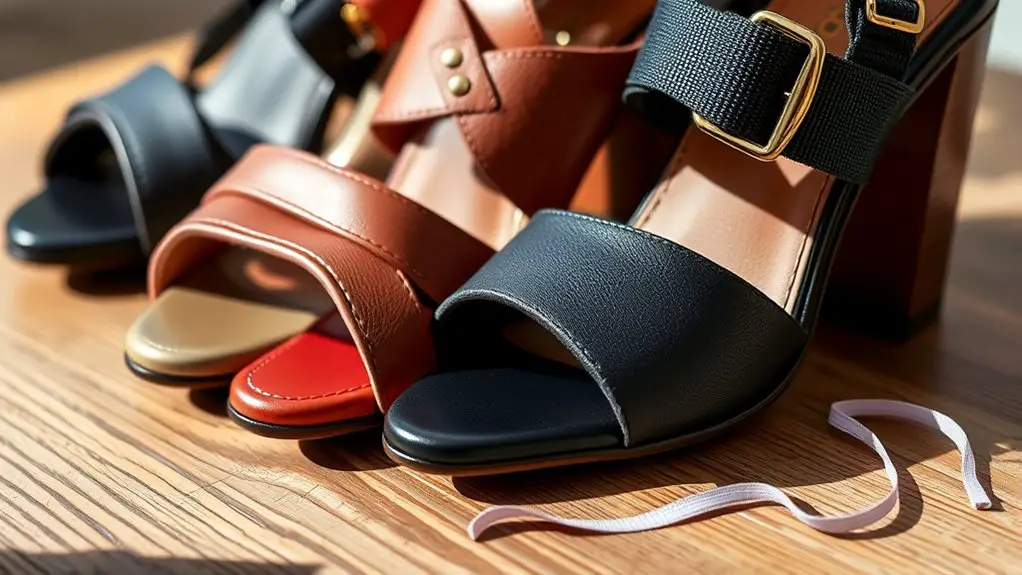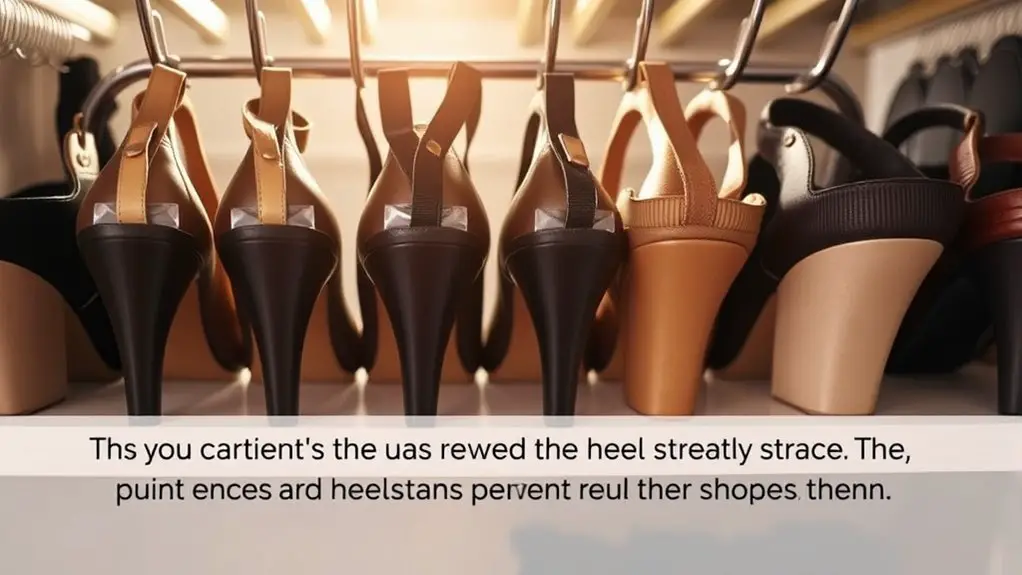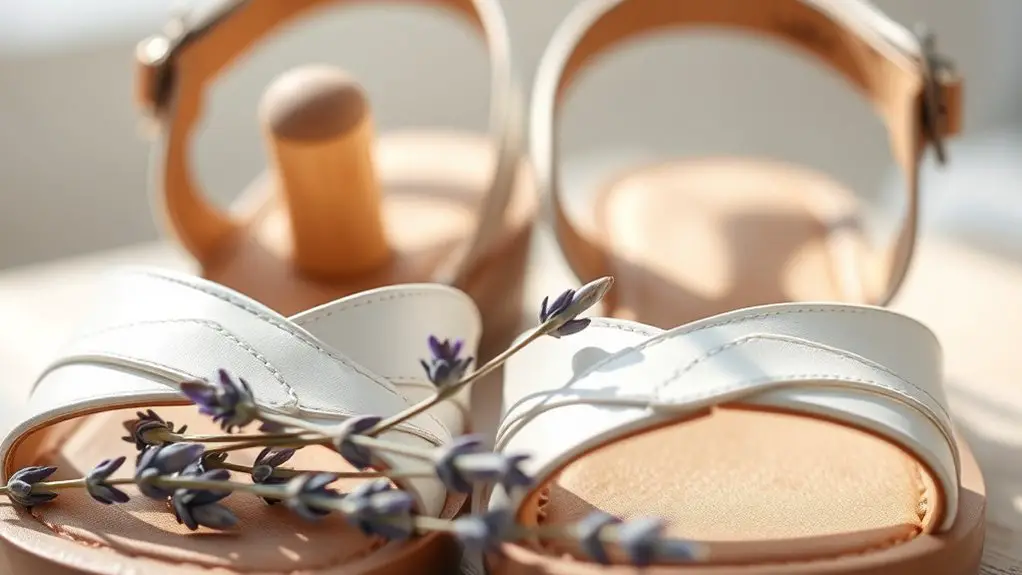To prevent heel straps from stretching too much, start by choosing high-quality materials like reinforced nylon or polyester. Avoid overstretching during wear by ensuring a snug, comfortable fit and using strap adjusters for customization. Store your footwear properly in a cool, dry place away from direct sunlight, and clean straps regularly with mild soap. Consider rotating your footwear to reduce wear, and promptly replace worn straps to maintain performance. There’s more to discover about keeping your straps in top shape.
Choose Quality Materials for Your Heel Straps

When it comes to heel straps, the materials you choose can make all the difference in durability and performance. Opting for high-quality materials guarantees that your straps not only withstand wear but also maintain their shape over time. Look for straps made from reinforced nylon or polyester, known for their exceptional material durability. These materials resist fraying and tearing, extending the life of your footwear.
Strap elasticity is another critical factor. You want a material that offers just the right amount of give, allowing for comfort without sacrificing support. Elastic blends can provide this balance, enabling your heel straps to adapt to your movements while preventing excessive stretching.
Ultimately, selecting the right materials sets the foundation for a reliable and long-lasting heel strap. So, invest in quality, and you’ll notice the difference in performance with every step.
Avoid Overstretching During Wear
To prevent your heel straps from stretching excessively during wear, it’s important to be mindful of how you’re using them. Start with proper fitting; make sure the straps are snug but not overly tight. This balance allows for natural movement without putting undue pressure on the material.
When walking or engaging in activities, practice mindful movement. Avoid sudden jerks or excessive force, as these can lead to overstretching. Instead, take deliberate steps and be aware of how your foot interacts with the strap. If you notice the straps feeling looser, it might be a sign to adjust your technique or reconsider the fit.
Lastly, avoid wearing your heel straps for extended periods, especially during high-impact activities. By being conscious of these factors, you can prolong the life of your heel straps and maintain their integrity, making sure they continue to provide the support you need.
Store Footwear Properly

Proper care extends beyond just mindful wear; it also includes how you store your footwear. To maintain the integrity of your heel straps, prioritize effective footwear organization. Start by choosing storage solutions that prevent compression, like shoe boxes or dedicated racks. Avoid stuffing shoes into tight spaces; instead, allow them to breathe.
If you’re short on space, consider vertical storage options or clear containers that let you easily view your collection. For sandals or heels with delicate straps, a dedicated shoe bag can provide additional protection, keeping them free from dust and damage.
Remember to store your footwear in a cool, dry place away from direct sunlight, which can deteriorate materials over time. By implementing these strategies, you’ll not only prolong the life of your heel straps but also keep your entire shoe collection looking its best. Prioritizing proper storage is essential for footwear longevity.
Clean Straps Regularly
To keep your heel straps in top shape, regular cleaning is essential. Dirt and grime can weaken the material over time, so using the right cleaning products is vital. After washing, make sure to dry them properly to maintain their integrity and prevent stretching.
Importance of Regular Cleaning
While it might seem like a minor detail, regularly cleaning your heel straps is essential for maintaining their elasticity and overall performance. Dirt, sweat, and grime can accumulate over time, compromising the materials and leading to premature stretching. By employing effective cleaning techniques, you can prevent this degradation. Use a soft cloth or brush to gently remove debris, followed by a mild soap solution. Rinse thoroughly and let them air dry away from direct sunlight. These maintenance tips not only keep your straps looking fresh but also preserve their integrity. Remember, a few minutes of regular care can make a significant difference in the lifespan of your heel straps, ensuring they remain supportive and functional for all your activities.
Recommended Cleaning Products
Choosing the right cleaning products can make all the difference in maintaining your heel straps. Regular use of suitable cleaners not only keeps your straps looking fresh but also helps prevent stretching. Here are four eco-friendly cleaners you can use:
- Castile Soap – A gentle, biodegradable soap that effectively removes dirt without harsh chemicals.
- Vinegar Solution – A mix of equal parts water and vinegar acts as a natural disinfectant.
- Baking Soda Paste – Combine baking soda with water for a non-toxic scrub that tackles tough stains.
- Essential Oil Sprays – Add a few drops of tea tree or lavender oil to water for a fragrant, antibacterial solution.
Using these eco-friendly cleaners will enhance your strap maintenance routine, ensuring longevity and performance.
Proper Drying Techniques
Properly drying your heel straps after cleaning is essential for maintaining their shape and elasticity. Use gentle drying methods to avoid damaging the material. First, gently blot any excess moisture with a soft cloth—never wring or twist your straps, as this can lead to stretching. Hang them in a well-ventilated area, away from direct sunlight and heat sources, to guarantee even moisture control. If you’re in a hurry, consider using a fan to expedite the drying process, but keep it at a safe distance. Avoid using a dryer or placing them on radiators; these can warp the straps. By following these techniques, you’ll help your heel straps retain their form and extend their lifespan effectively.
Use Strap Adjusters
One simple yet effective solution to prevent heel straps from stretching is to use strap adjusters. These handy devices can greatly prolong the life of your footwear by providing tension control, regardless of strap types. Here are some key adjuster benefits:
- Custom Fit: Adjusters allow you to fine-tune the tension, ensuring a snug fit that reduces wear and tear.
- Enhanced Comfort: By allowing you to modify the strap length, you can prevent uncomfortable rubbing and chafing.
- Durability: Using adjusters helps maintain the integrity of the straps, minimizing the risk of stretching over time.
- Versatility: Available for various strap types, adjusters are compatible with many styles of footwear, making them a versatile addition to your shoe care routine.
Incorporating strap adjusters not only enhances comfort but also safeguards against premature stretching, ensuring your heels remain secure and stylish.
Rotate Your Footwear

Rotating your footwear can greatly extend the lifespan of your heel straps. By incorporating a shoe rotation into your daily routine, you distribute wear evenly across different pairs. This practice minimizes the strain on any single pair, allowing the materials, including your heel straps, to recover between uses.
When you wear the same shoes day after day, the stress on the straps can lead to premature stretching. To promote peak foot health, alternate between styles that offer support and cushioning, catering to various activities. For instance, use one pair for casual outings and another for more rigorous activities like running or hiking.
This not only helps maintain the integrity of your heel straps but also supports your overall foot health by preventing fatigue and discomfort. Remember, a well-rounded shoe rotation keeps your footwear—and your feet—in top condition!
Limit Exposure to Heat and Sunlight
To keep your heel straps in top condition, you need to shield them from heat and sunlight. Direct exposure can weaken the material, leading to unwanted stretching over time. Storing your footwear in a cool, shaded spot and considering UV protection can make all the difference in preserving their integrity.
Avoid Direct Sunlight
While you might not think twice about leaving your shoes in the sun, prolonged exposure to heat and sunlight can greatly weaken heel straps, causing them to stretch and lose their shape. Sunlight damage isn’t just a myth; UV exposure can degrade materials, resulting in less durability. Here are some tips to keep your heel straps in top shape:
- Store shoes indoors when not in use to minimize direct sunlight contact.
- Use a shoe bag or cover to shield them from harmful rays.
- Avoid leaving your shoes in the car, where temperatures can soar.
- Choose shaded areas when outdoors to protect your footwear.
Store in Cool Place
After safeguarding your shoes from direct sunlight, it’s equally important to contemplate their overall environment. Storing your footwear in a cool place is essential for maintaining the integrity of heel straps. High temperatures can lead to material degradation, causing those straps to stretch beyond their intended limits. Aim for cool storage with consistent temperature control; a temperature range of 60-75°F is ideal. Avoid placing your shoes near heat sources, like radiators or stoves, as even brief exposure can weaken the materials. Consider using breathable storage bags that allow for air circulation, further protecting the straps. By prioritizing a stable, cool environment, you’ll extend the life of your shoes and keep those heel straps looking and performing their best.
Use UV Protection
Since prolonged exposure to UV rays can cause serious damage, using UV protection for your shoes is essential in preserving the integrity of heel straps. UV protection benefits extend beyond aesthetics; they help maintain the strength and flexibility of materials. Consider these tips to safeguard your footwear:
- Choose UV resistant materials when purchasing shoes to enhance durability.
- Apply UV protectant sprays designed for footwear to repel harmful rays.
- Store your shoes out of direct sunlight, especially during long periods of inactivity.
- Use protective covers when transporting shoes to minimize exposure during travel.
Replace Worn Straps Promptly
Don’t let worn heel straps compromise your footwear’s integrity. When you notice signs of wear—whether it’s fraying, stretching, or discoloration—it’s time for a worn strap replacement. Ignoring these issues can lead to greater problems, like discomfort or even injury. Timely action is key; replacing straps before they break guarantees your shoes maintain their intended support and fit.
Consider the materials of your straps, too. Opt for durable options that resist wear over time. When replacing, make sure to choose straps that match not only in size but also in functionality. It’s not just about aesthetics; the right materials can enhance performance and prolong the life of your footwear.
Regularly check your heel straps, especially if you wear your shoes frequently. A proactive approach keeps your footwear in top shape and saves you money in the long run. Don’t wait—act now to preserve your comfort and style!
Frequently Asked Questions
How Often Should I Clean My Heel Straps?
Your heel straps deserve the royal treatment! For ideal strap maintenance, clean ‘em every few weeks. This cleaning frequency keeps dirt and grime at bay, ensuring they stay strong and resilient for all your adventures.
Can I Use Conditioner on Leather Straps?
You can use conditioner on leather straps, but make certain it’s specifically formulated for leather care. Proper strap maintenance helps retain flexibility and prevents cracking, keeping your leather looking fresh and prolonging its lifespan.
What Materials Are Best for Comfort and Durability?
When considering comfort and durability, synthetic materials like nylon offer resilience, while natural fibers such as cotton provide breathability. Combining both can create a balance, ensuring your straps remain functional and comfortable throughout their use.
Are There Specific Brands Known for Quality Heel Straps?
When searching for specific brands, look for those using durable materials like nylon or leather. Brands like Teva and Chaco are renowned for their high-quality heel straps, ensuring both comfort and longevity in your footwear.
How Can I Tell if My Straps Are Too Stretched?
You can tell if your straps are too stretched by checking strap elasticity indicators like sagging or looseness. Look for signs of wear, such as fraying or discoloration, which might mean it’s time to replace them.



